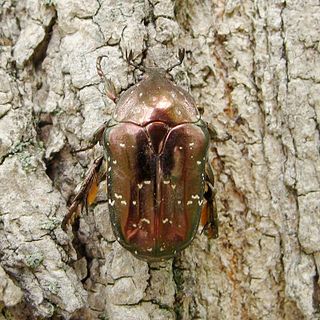Related Research Articles
Amburana acreana is a species of legume in the family Fabaceae. It is found in Bolivia, Brazil, and Peru. Its main threat is habitat loss.
Abarema acreana is a tree species in the legume family (Fabaceae). It is a rather mysterious plant and may be endemic to Brazil. Fruiting trees apparently have never been found, and thus it is not clear whether this plant belongs into the genus Abarema, or in Hydrochorea, or elsewhere.
Hydrochorea is a genus of flowering plants in the family Fabaceae. It belongs to the mimosoid clade of the subfamily Caesalpinioideae. It contains a mere 3 species at present:

Restrepia cuprea, the copper-colored restrepia, is a species of orchid endemic to Colombia.

Chersotis cuprea is a moth of the family Noctuidae.

Acrodipsas cuprea, the copper ant-blue or cuprea ant-blue, is a butterfly of the family Lycaenidae. It is found in Australia, from southern Queensland to Victoria.

Protaetia is a genus of beetles of the family Scarabaeidae, occurring primarily in Asia, and containing over 300 species.
Abrenthia is a genus of Glyphipterigidae. It was described by August Busck in 1915, and contains only one species Abrenthia cuprea. This species is found in North America, including Florida, Illinois and Iowa.
Euphaedra cuprea is a butterfly in the family Nymphalidae. It is found in Équateur and Sankuru in the Democratic Republic of the Congo.

Napeogenes sylphis is a species of butterfly of the family Nymphalidae. It is found in South America.
Searenia cuprea is a species of moth of the family Tortricidae. It is found in Santa Catarina, Brazil.
Calliini is a tribe of longhorn beetles of the subfamily Lamiinae.
Purusia acreana is a species of beetle in the family Cerambycidae. It was described by Lane in 1956. It is known from Brazil, Ecuador and Bolivia.
Eucalyptus cuprea, commonly known as the mallee box, is a species of mallee that is endemic to the west coast of Western Australia. It has rough, flaky bark on the base of its trunk, smooth coppery-coloured bark above, lance-shaped adult leaves, flower buds in groups of seven, creamy white flowers and conical to cup-shaped fruit.

Sport Clube Humaitá, commonly referred to as Humaitá, is a Brazilian professional club based in Porto Acre, Acre. They play in the Série D, the fourth tier of Brazilian football, as well as in the Campeonato Acreano, the top flight of the Acre state football league.

Diopatra cuprea, commonly known as the plumed worm, decorator worm or sometimes ornate worm, is a species of polychaete worm in the family Onuphidae, first described by the French entomologist Louis Augustin Guillaume Bosc in 1802. It is native to the northwestern Atlantic Ocean, the Caribbean Sea and the Gulf of Mexico.

Argia cuprea, the coppery dancer, is a species of narrow-winged damselfly in the family Coenagrionidae. It is found in Central America, North America, and South America.

Cariblatta is a genus of cockroach in the family Ectobiidae. There are more than 70 described species in Cariblatta.

The Malabar imperial pigeon or Nilgiri imperial pigeon is a species of bird in the family Columbidae. It is endemic to the Western Ghats of India.

Protaetia cuprea, also known as the copper chafer, is a species of chafer in the family Scarabaeidae. This species is also known as the rose chafer, and has a wide geographic distribution extending from Canary Islands, Portugal and Spain in the west towards Vladivostok in the Russian Far East, Mongolia, and northern China.
References
- ↑ Biolib.cz - tribus Acreana cuprea. Retrieved on 8 September 2014.